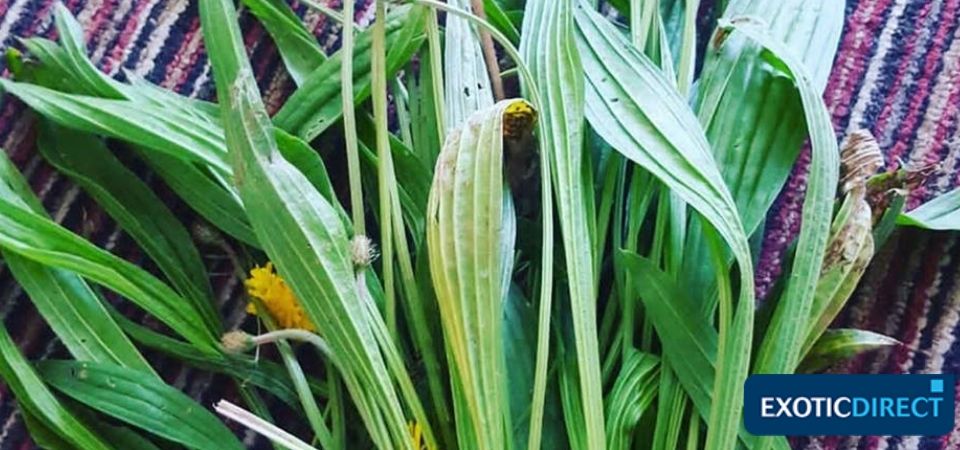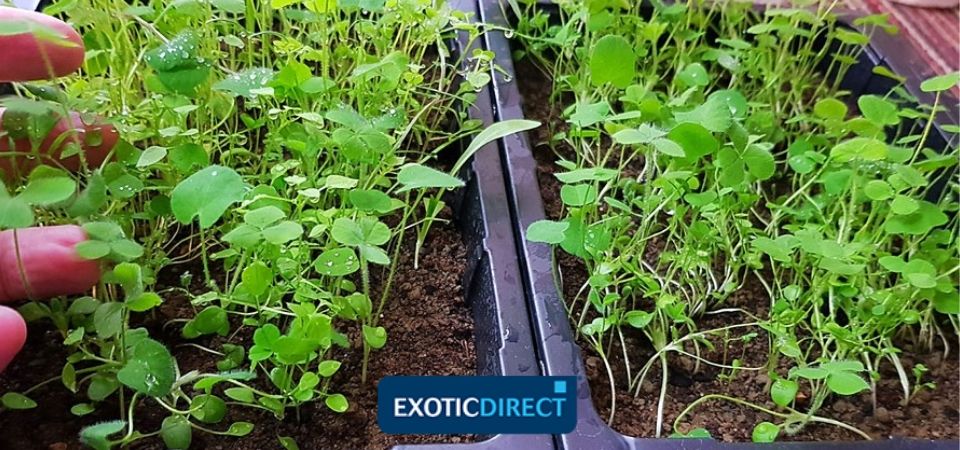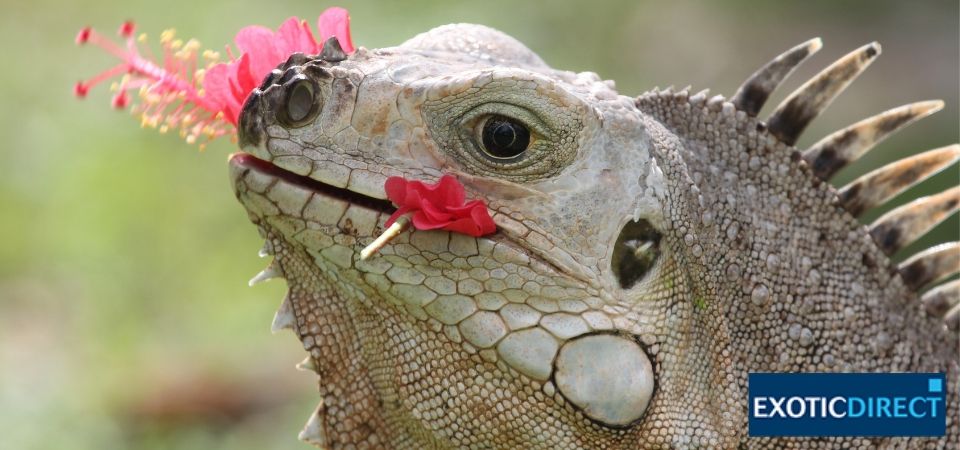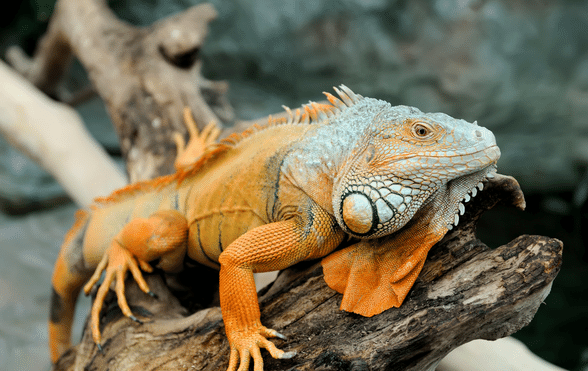Learn how to keep your Iguana healthy by feeding them the best diet
Get a quote to insure your Iguana for £1,000 of vet fees. Up to 3 pets per policy | We’ve been insuring exotic pets since 1996 | Check out our Customer reviews on Feefo.
What should I feed my Iguana? | Can I feed my Iguana Insects? | What foods should Iguanas not eat? | How often should I feed my Iguana? | Why has my Iguana stopped eating? | What does a healthy and unhealthy Iguana look like? | Taking long-term care of your Iguana | Additional resources
The common green Iguana like all its sub-species cousins are pretty much strictly herbivores, folivores and frugivores. This means they eat mainly leaves, weeds, flowers and fruits.
And like with any captive kept reptile, what we feed them is paramount to their direct health. They have no choice with what’s on offer, so it’s down to us to make things as nutritionally beneficial and worthwhile for them as humanly possible.
This diet will be restricted somewhat by seasonal vegetation varieties, but you’re still looking at hundreds of plants, flowers, herbs and fruit varieties being consumed. Something most care-sheets for the species fail to mention, which to me is a shocking exclusion!
Iguanas have evolved and thrived over millions of years with this variety on offer. This should be remembered when caring for our captive Iguana (or any species for that matter).
A few decades of captive breeding can never undo millions of years of evolutionary needs and requirements when it comes to an Iguanas diet and setup.
What should I feed my Iguana?
Firstly, I’d suggest planting some flower and weed seeds such as:
- Dandelion
- Alfalfa
- Plantain
- Ribwort
- Bittercress
- Clover
- Mallow
- Hedge-mustard

These are nutritious and are a great start. The ProRep Tortoise seed range, as well as the Lucky reptile herb garden range can be bought from the Northampton Reptile Centre.
Even if you don’t have a garden you can buy the ProRep tortoise growing kits. And you have yourself a window box that will grow the above inside the house without issue (see my own attached photo of one of my own ProRep boxes)
As for flowers. The same really. Search Amazon and eBay and plant your own. Go for the likes of:
- Pansy
- Hibiscus
- Rose
- Nasturtium
- Dahlia
- Viola
- Lilac
- Fuchsia
- Marigold
- Snapdragon
- Apple blossom
- Lavender
- Chrysanthemum
- Optunia
I wouldn’t choose shop purchased flowers; they have generally been treated to enhance growth and colour and some have even had pesticides used on them.
Of course, you can safely forage you own weeds too; this is one of my favourite things to do ever! (yes, I’m sad like that). You can collect them from grounds away from roads. You should aim for:
- Nettles
- Birch leaf
- Beech leaf
- Hazel leaf
- Hawkbit
- Chickweed
- Sowthistle
- Bindweed
You can also purchase shop or supermarket greens, salad, herbs and fruit like:
- Spring Greens
- Florette mix
- Lambs lettuce
- Water-cress
- Pak choi
- Basil
- Mint
- Oregano
- Rosemary
- Sage
All Squash varieties:
- Berries
- Mango
- Papaya
- Mellon
- Fig
- Wild rocket
- Pumpkin
- Parsnip
- Sweet potato
- Carrot
- Bell Pepper
- Marrow
- Cucumber
- Spinach (not too much of the Spinach, as can stop the absorption of calcium. But a little weekly is beneficial)
No acidic fruits should be fed however.
As you can see, what is fed is down to you the keeper. But to cover as many bases as we can, it’s always best to provide a wide variety on a nutritional scale. There’s really no excuse for not doing so.
 Why not try feeding your Iguana ProRep weeds?
Why not try feeding your Iguana ProRep weeds?
Get a quote to insure your Iguana for £1,000 of vet fees. Up to 3 pets per policy | We’ve been insuring exotic pets since 1996 | Check out our Customer reviews on Feefo.
Can I feed my Iguana Insects?
Although they’ve been seen to eat a few insect species in wild conditions and under certain circumstances – this is not something they have evolved to need. And you should not feed them.
They struggle to process the meat and proteins, putting a huge strain on their liver and kidneys – which ultimately can be fatal.
What foods should Iguanas not eat?
Iguanas should not eat meat or bugs. You should stick with plants, leaves, flowers and fruits.
Other foods can be bad for Iguanas if they’re fed too much of them. An example would be two popular greens found on the food list of most reptile keepers. They are kale and spinach.
Kale is high in goitrogens and too much of this can cause thyroid issues. Spinach has a high oxalate content and too much of this can bind the calcium absorption of the Iguana (as with all reptiles). This can cause issues that lead to MBD (metabolic bone disease)
In moderation both kale and spinach are hugely beneficial as part of a varied diet.
Lettuce is another vegetable that should be eaten in moderation. There are different varieties of lettuce you can feed your Iguana. Some such as Iceberg lettuce have low nutritional value but others such as Romaine, Lambs and Gem are better and all offer great hydration options, but again variety is the key here.
How often should I feed my Iguana
You should feed your Iguana daily. There are a few websites that say you should feed them every 2 or 3 days but with a healthy varied diet, a good daily feed is perfect.
You should feed in the morning, thus allowing for a full day of ample heat and UVB (Ultraviolet light) for digestion and basking.
It’s best to feed a good amount until the Iguana has actively moved away from the food. You’ll have a good idea of how much to feed by observing the feeding of the Iguana and adjusting as needed.
Why has my Iguana stopped eating?
There could be a number of reasons why an Iguana stops eating.
The main cause and this is true for most reptiles is inadequate temperature. Too low to digest being the main one. Poor UVB and humidity is another cause.
Without all of these being optimal – food digestion becomes problematic. Thus, the Iguana does not want to eat.
Parasites are another common reason. Most reptiles carry a small load of internal parasites which are mostly of no issue to them. A healthy Iguana will keep these parasites under control internally without any problems.
It’s only when illness, or during times of stress that these parasite numbers can gain more of a foothold internally, causing issues and symptoms such as going off food. With any uncharacteristic behaviour from the Iguana, you should seek assistance from your Herp Vet.
Dealing with parasites is an easy fix. It normally involves a dose or two of the relevant parasite medication to kill off the parasites. Once this happens, your Iggy will be back eating everything in it’s wake before you know it.

What does a healthy and unhealthy Iguana look like?
With any reptile species, there are a number of things to look for that can tell you what condition they are in. The same applies for Iguanas.
- Eyes – Nice bright clear eyes. No weeping or dryness.
- Mouth – No sores, weeping or mucus. These areas should be nice and clear and clean
- Digits – Count those toes. Five on each limb and no claws/nails missing
- Spikes – Check the row of spikes/spines that run from the head to tail. There shouldn’t be any missing or have stuck shed around them
- Limbs and tail – These should have no abnormal bends, bowing, or kinks in them. Signs of such could mean MBD (Metabolic bone disease)
Taking long-term care of your Iguana
If you’re planning on buying an Iguana as a pet, you will be getting a beautiful and intelligent reptile. A healthy, well looked after Iguana can live up to 20 years and more but taking care of one requires time, dedication and experience.
They also need space, the right setup parameters and a good diet to survive and thrive in captivity.
Keeping an Iguana is a lifelong commitment and there will naturally be illness and health issues to deal with along the way. There will hopefully be many good times but a few bad times I’m sure.
Personally, I don’t think an Iguana is a “beginner” reptile at all. Having some experience of reptile behaviour is something I’d consider vital for such a species, particularly for one that can commonly be very territorial.
The reading of a reptile’s (and specifically Iguanas) body language is an absolute must.
You also need to consider the living arrangements of your Iguana. They require a huge living space, with the Green Iguana growing up to 6ft in length once fully grown.
You are going to need at least a 6ft x 6ft x 2ft set-up. Despite what some breeders or pet shops say. It’s all about usable surface area and bigger is always going to be better with this large tropical species.
Owners also need to ensure their Iguanas have the required UVB (ultraviolet light) and temperature needed to remain healthy.
If you can’t provide the best of what is needed then a reptile is not for you. Owning an Iguana means providing them with the very best quality in terms of diet and living arrangements, it is not appropriate to cut corners when it comes to their well-being.
Of course, with care, interaction and the correct feeding, you’ll earn the trust of your reptile and have a happy and healthy companion for many years.
Additional resources:
For your foraging needs, download the PlantNet app. Available on both iPhone and Android app store.
This app allows you to take a photo of the weed, flower or plant in question. And will aim to identify it via that photo from its extensive database.
Secondly. Download the TortoiseTable Plant Database app. Again, available on both formats.
This gives you all the information on if the said wee, plant or flower is safe to feed. And it’s recommended regularity within the diet.
And the database is huge!
So, use it in conjunction with the PlantNet app. You can then identify weeds and flowers etc, and deem if safe, without all the guess work.
*One of own Facebook groups will be suited to and Iguana questions: www.facebook.com/groups/lizardnetwork
You can also visit my website The Reptile Networks for more advice and information.
Get a quote to insure your Iguana for £1,000 of vet fees. Up to 3 pets per policy | We’ve been insuring exotic pets since 1996 | Check out our Customer reviews on Feefo.
Pete Hawkins may receive commission for pet insurance sales that result from you clicking on a link within this article.

